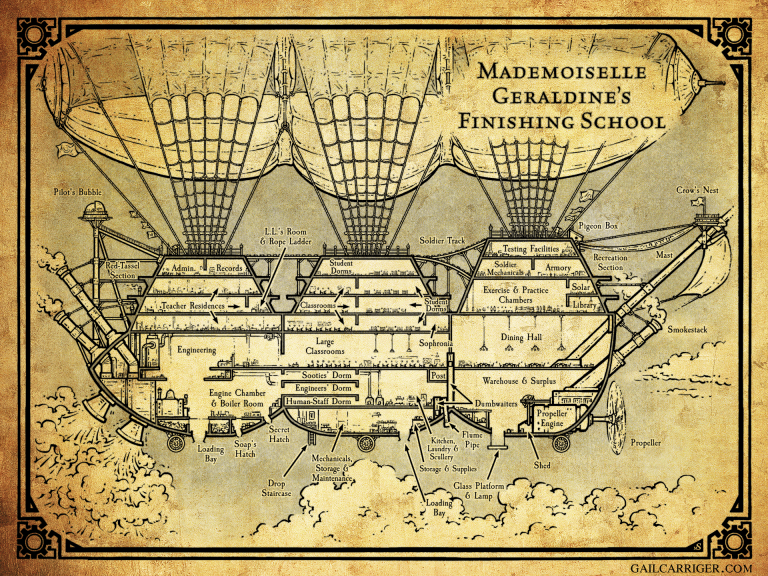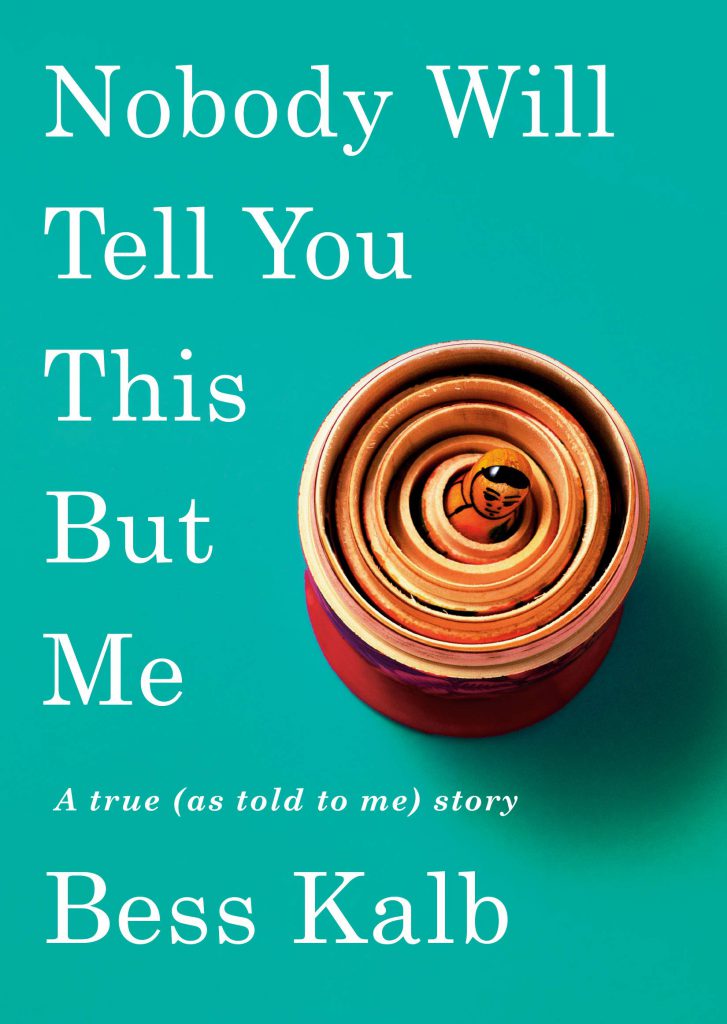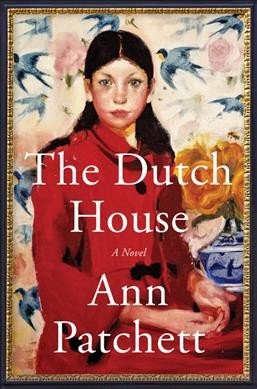Search the Blog
Categories
- Books & Reading
- Broadband Buzz
- Census
- Education & Training
- General
- Grants
- Information Resources
- Library Management
- Nebraska Center for the Book
- Nebraska Memories
- Now hiring @ your library
- Preservation
- Pretty Sweet Tech
- Programming
- Public Library Boards of Trustees
- Public Relations
- Talking Book & Braille Service (TBBS)
- Technology
- Uncategorized
- What's Up Doc / Govdocs
- Youth Services
Archives
Subscribe
Tag Archives: Friday Reads
Friday Reads: Mistress of the Art of Death by Ariana Franklin
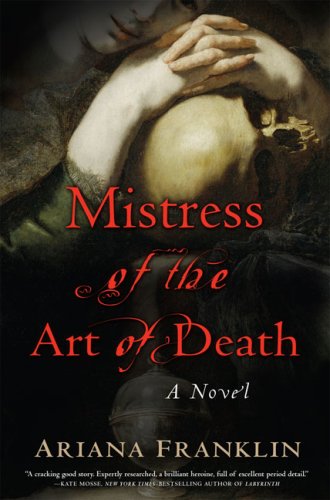
Historical Fiction meets Murder Mystery is always a good read in my book. In this case the setting is Medieval Europe, more specifically Cambridge, England. Our heroine is Adelia Aguilar, a trained doctor and what we would call a medical examiner. Rare and heretical for the time, she must pretend to be an assistant and translator for her long time Muslim protector, Mansur. Think Rizzoli and Isles, but with knights, monks, and convents.
Four children have been brutally murdered in Cambridge. The townspeople have accused the local Jewish community of the crimes and forced them to flee. The disruption to King Henry II’s tax revenues leads him to ask for outside help from the King of Sicily. Thus our story begins with Adelia’s summoning from the Salerno School of Medicine.
If you love procedural drama intertwined with historical facts, this is the book for you. Even better, it’s a series of five books.
Franklin, Ariana. Mistress of the Art of Death. G.P. Putnam’s Sons. 2007.
Posted in Books & Reading
Tagged Ariana Franklin, Book Review, Friday Reads, Mistress of the Art of Death
Leave a comment
Friday Reads: Prairie Forge by James Kimble
James Kimble’s Prairie Forge is the 2021 One Book One Nebraska selection. Prairie Forge is the story of a remarkable undertaking, launched in Nebraska, that inspired replication throughout the United States. With the United States entering World War II and the urgent need for resources, iron production was needed in ever-greater quantities for production of ships, planes, vehicles, weapons, and many other military necessities. Scrap metal was a critical need. That was the impetus for the Nebraska scrap metal drive of 1942.

Henry Doorly, Omaha World Herald publisher, inspired by a challenge from his wife, Margaret Hitchcock Doorly, initiated a scrap metal collection project in Omaha. With motivation and dedication, Doorly developed a plan to encourage Omaha residents to donate scrap metal for the war effort. Committing the resources of the Omaha World Herald and his staff, Doorly initiated and championed the effort that expanded across Nebraska.
While not initially expected, Doorly’s plan grew from its beginning in Omaha to spread statewide. Competition among counties, businesses, communities and schools resulted in 67,000 tons of scrap metal gathered within a three week period. It wasn’t easy; there were numerous challenges and obstacles to overcome. Success resulted from motivation, inspiration, persistence, commitment to the cause, and the competitive spirit that led Nebraskans to meet the challenging goals set for the project.
The Nebraska plan and its achievements became a model for a national scrap metal drive. Ultimately, the national effort resulted in volunteer “scrappers” collecting 5 million tons of scrap. Professor Kimble contends that “the Nebraska Plan was successful because it brought the war home to civilians, enabling them to participate directly in the battle as something akin to combatants. Students, retirees, housewives, blue-collar laborers, and even children felt themselves becoming integral parts of the war.” Leadership came from many people and organizations across Nebraska, and notable were the contributions of news outlets that provided information for community organizers and other volunteers.
The scrap metal drive may be an overlooked footnote in World War II history books, but it was a significant contribution to equipping the war effort and the eventual outcome.
One book reviewer remarked that Prairie Forge should be in every Nebraska public library. Nebraskans are encouraged to read this remarkable book.
James J. Kimble, Ph.D., is Professor of Communication, College of Communication and the Arts, Seton Hall University. An expert in the communication field, he is the co-producer of Scrappers: How the Heartland Won World War II, a feature documentary on the 1942 scrap drives. James Kimble’s hometown is Norfolk, Nebraska.
Kimble, James J. Prairie Forge: The Extraordinary Story of the Nebraska Scrap Metal Drive of World War II. Bison Books. 2014,
Friday Reads: Clandestine
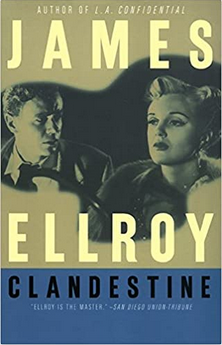
“I’m a take-me-as-l-am person, and all the rest is water under the bridge. You can’t change yesterday any more than you can predict what’s gonna happen tomorrow.”
–Glen Campbell
Recently, I watched the documentary film Echo in the Canyon, which triggered a chain reaction of reading and listening activity. On the listening level, it was a revisit to Pet Sounds by the Beach Boys and a few others. Arguably, one of the best albums of all time, and specifically, the song I Just Wasn’t Made For These Times strikes a chord for me. For the record, I think it’s a disgrace that Mike Love is touring under the Beach Boys moniker, sans Brian Wilson, but I do acknowledge that Mike’s contributions have been underrated. In addition, the amount of those contributions certainly can be up for debate, but at this point, I’m not sure it matters much. Having said all this, the book reading reaction to Echo was first to pick up yet another music biography. This time, I gravitated to the latest Neil Young book, Special Deluxe: A Memoir of Life and Cars. Likely, this will be written about in the future to add to my FR musician catalog of Tom Petty, Prince, the Wrecking Crew, and the disaster at Altamont involving the Rolling Stones. Arguably, the attraction to Neil was threefold: (1) the coverage of Buffalo Springfield in Echo; (2) the large absence of Neil from it; and (3) the iconic sideburns, which have remained constant over the years. Now, in the world of unique tidbits of one’s appearance, the sideburns are a difficult animal. The lamb chops could arguably have been unique at one point in time for many individuals (and they certainly are for a guy like Neil), but like most everything else in today’s world, are now over-done. In all seriousness, in order to really pull this off, you need the hairstyle to go with the burns, like this example. Note to self: Scour thrift stores for pastel leisure suit to go full tilt – this could be the originality that sets my appearance over the top. For more inspiration check out Queen’s Gambit for applicable ideas for any hip ladies and gents. For the cat writing this (me), the current COVID look is closer to John Quincy, minus the bald spots. Wa-wa.
Now, having decided to pass on writing about Neil, I picked up another period writer from a time which if I could teleport, I certainly would. So, as the “The Cowboy” from Mullholland Drive says, let’s get right down to it. That writer is James Ellroy and the book is Clandestine. When I say teleport, the time period seems cogent, but Ellroy’s portrait of L.A. certainly is bleak. Clandestine follows many of Ellroy’s other narratives, in this case LAPD cop Fred Underhill. The themes in Ellroy’s L.A. are similar: Murders of women, corrupt cops, hopheads, and other “degenerates.” This is familiar Ellroy territory, and anyone having read anything by him will feel right at home. It doesn’t make the mysteries (the book follows multiple murders) any less interesting, just the look and feel remain constant. There’s also the cross-pollination of some characters you may recognize from L.A. Confidential, such as the ruthless and crooked Lt and then Captain Dudley Smith. In actuality, Clandestine was Ellroy’s second work (after Brown’s Requiem), published in 1982. It’s easy to see his progression from Clandestine to his impeccable L.A. Quartet (The Black Dahlia, The Big Nowhere, L.A. Confidential, and White Jazz).
Now for a brief synopsis: In Clandestine, the story follows the main character, Fred Underhill, and his relationships. His relationship with the LAPD, with his partner, with Dudley Smith, his DA lover, and of course the victims and suspects. Clandestine describes the secret program run by Smith, to conduct investigations and interrogations as a part of secret program of LAPD cops, and has another hidden meaning. But this story is quite a bit more about the change that takes place among Fred Underhill, over a period of time as he investigates murders. This book isn’t Ellroy’s best work by any stretch of the imagination, and the territory has been covered in a more entertaining fashion in the L.A. Quartet. However, if you like his writing style and a decent mystery, you may find this book to be a good read.
Ellroy, James. Clandestine. Avon Books. 1982.
Friday Reads: Bob by Wendy Mass

Confession: my son is a reluctant reader. This pains me both as a mother and a librarian. He was introduced to books as an infant, visited me at the library, was (and is) read to constantly, and there are books everywhere in our house. He can read just fine; it’s just not his preferred hobby. He’ll do whatever it takes to get through his daily 20 minutes of assigned reading and not a minute more. This is obviously a me-problem; what librarian doesn’t want their kid to know the joy of reading?
So I was pleasantly surprised when he voluntarily brought home a middle-grade novel this week. He will often check out a book about animals or cars, or just choose to read picture books aloud to his sister. But this week, he handed me Bob by Wendy Mass. “I heard it’s a good story.” Indeed, it is – I read it in early 2019 and it was a 2020/21 Golden Sower nominee. We are reading a couple of chapters a night (don’t want to exceed that 20 minute limit!).
Bob is the story of a small green creature, dressed in chicken suit, waiting not-so-patiently in a closet for his friend to return. That friend, Livy, has been gone for 5 years and when she does show up, she doesn’t remember Bob or the promise she made to him when she was 5 years old – to help him find his home. Now that they are reunited, they set off to figure out the mystery of Bob.
Bob may or may not kick off a lifelong affinity for the written word, but for this winter break at least, I’m going to savor each page read aloud by my favorite reluctant reader.
Mass, Wendy. Bob. Feiwel & Friends, 2018.
Posted in Books & Reading, General, Youth Services
Tagged #FridayReads, Book Review, Friday Reads, GoldenSowerAward, middle grade, read aloud, Wendy Mass
Leave a comment
Friday Reads: Shadow of the Batgirl
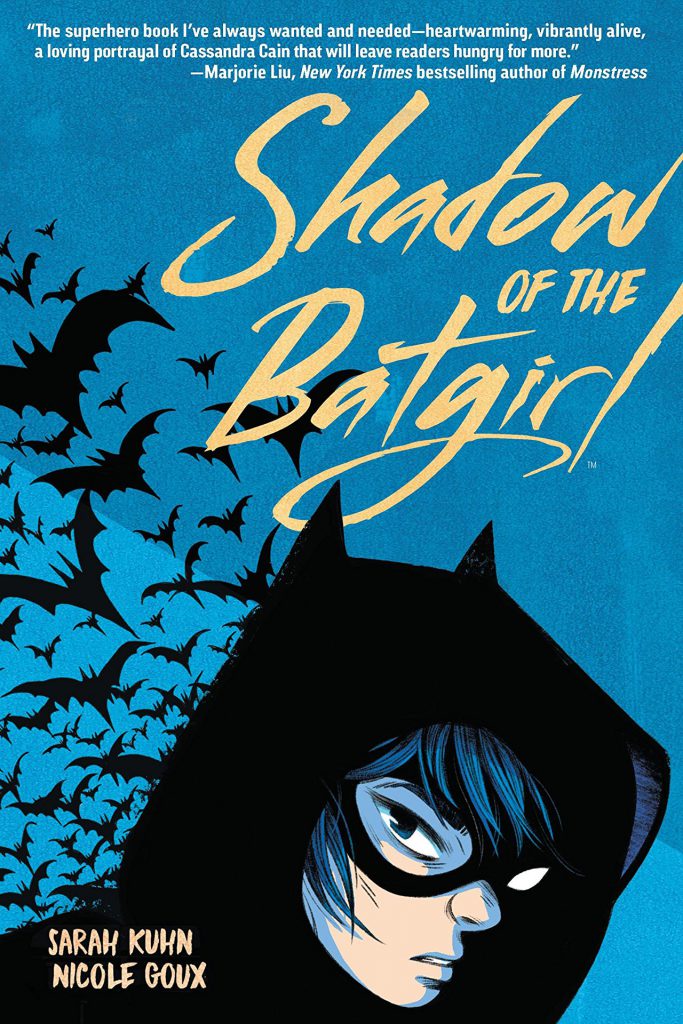
This probably isn’t the Batgirl you think it is.
Shadow of the Batgirl, written by Sarah Kuhn and illustrated by Nicole Goux, is another re-imagining of an iconic origin story, this time of the lesser known Batgirl, Cassandra Cain. I’ve read the previous comic series about Cassandra, and I’ve always enjoyed her more edgy style.
This version of Cassandra Cain is similar to her original story, but a bit lighter in tone. I still really liked this new take on her beginnings and evolution into Batgirl. And much of the story takes place in Gotham Public Library, which makes it a perfect read for the librarian in me!
Cassandra has been raised as an assassin, and she knows nothing of the world outside of her training. During an encounter where she is supposed to kill a man, she has a startling realization about herself and doesn’t follow through with her assignment. She runs away from her former life, determined to figure out who she is and who she wants to be.
With the help of ramen restaurant owner Jackie Fujikawa Yoneyama and librarian Barbara Gordon, Cassandra learns about her own past and tries to find out what happened to Batgirl, who has mysteriously disappeared. And Barbara just happens to use a wheelchair, which readers of another Batgirl may recognize. No spoilers!
This well-written stand-alone graphic novel leaves you wanting more. I hope to see this Cassandra Cain in the future.
Posted in Books & Reading, Youth Services
Tagged #FridayReads, Friday Reads, FridayReads
Leave a comment
Friday Reads: Clap When You Land by Elizabeth Acevedo
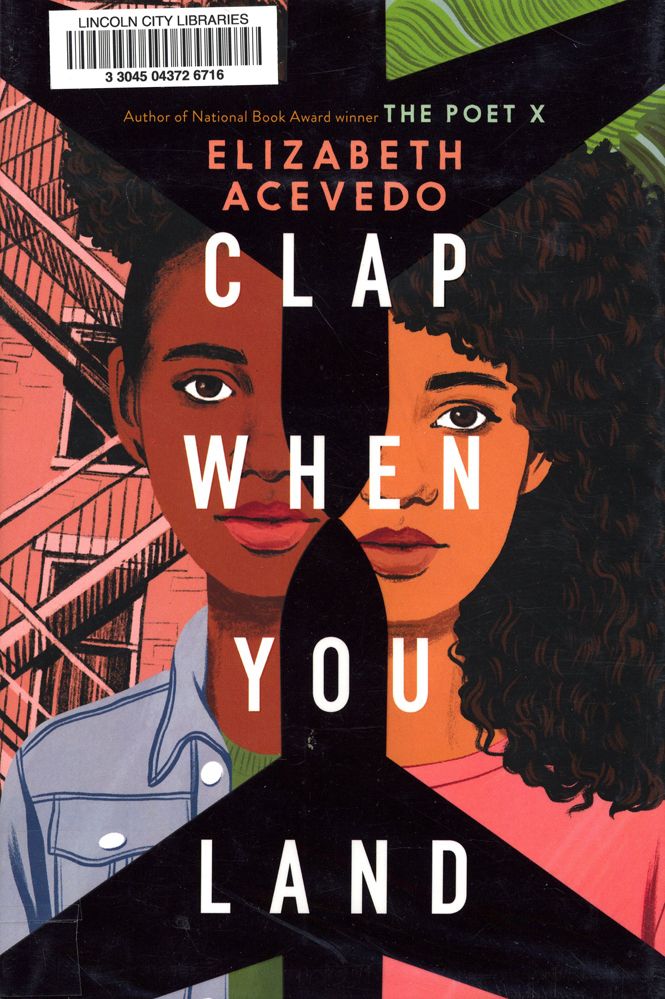
This novel is told in free verse and in the alternating voices of two almost 17-year-olds, who find out about each other and that they are half-sisters only after their father dies in a plane crash. Yahaira lives in New York with her parents and misses her father when he travels to the Dominican Republic every summer, she thinks it is for business. Camino lives with her aunt in the Dominican Republic and loves the summer since that is when her father is with her.
It includes their shock and grief at the loss of their father. The pain of overcoming the disappointment & betrayal they feel as they learn about his secret families; and realizing their futures are now at risk too.
It is also a celebration of family, and of the path to a hopefully better future for both daughters.
The author explains that it is a Dominican custom to clap when the plane lands the passengers back in the Dominican Republic.
Acevedo, Elizabeth. (2020). Clap When You Land. Quill Tree Books.
Friday Reads: War of the Foxes by Richard Siken
“Trust me. I have things to say” (14).
Poetry is a difficult genre to review. Poetry is a personal subject: for each of our bodies, there is a poetry that corresponds, that resonates and echoes with us.

Richard Siken’s Crush is my favorite collection of poetry – and one of my favorite books. I went through a period in my life when I read it once a week (on Sundays). I’ve recorded myself reading poems from Crush and sent the recordings to romantic prospects (with varying degrees of success, but that says nothing of Siken).
War of the Foxes is not Crush. There is a different amplitude about it. It is less concussive than Crush; more a stiletto knife through rib-spaces than a gut-punch (I like my poetry like a back-alley-fight — I like to come away with marks, impacted). And yet, perhaps it is not fair, I think, to talk about Foxes in the shadow of Crush (though how to separate them? there is no yolk from the white. if you do read Siken, you should start with Crush; the climax and catharsis of grief and the understanding of how he frames poetry is, perhaps, clearer in the older anthology).
So let’s talk about War of the Foxes. We begin in an art gallery. And that is what Foxes is, at the end of it, I believe: an art gallery. This may seem inactive. This is especially so if you do not particularly enjoy art galleries, have not been to an art gallery in a long time, or do not realize that while you are looking at the art, the art is also looking back. “All painting is sent downstream, into the future” (26). There’s the impression that the artist remains the active participant, the repetition of the act of creation, even as the viewer is looking (or we are). But what is the art, and who is the artist, and who is the viewer – these are the questions behind the obvious, behind the poems; “We do not walk through a passive landscape. The paint dries eventually” (6). Using something to talk about something else: this is poetry. (This is a good story). This is an exhibit on history, on war, on love. On birds. Ghosts. Paintings. “What is a ghost? What is a painting? Yes and yes, / the same answers” (42). War of the Foxes invites us to look within each frame and to see what we can find — ourselves, and maybe each other. “What’s the difference between me and the world? / Compartmentalization” (40). Connection is the art of it.
When I selected this book to review and began my post, I didn’t know that I would wake up on December 4th to the news of a new poem by Richard Siken. This is wonderful news because, in the Spring of 2019, Siken suffered a stroke and underwent a long recovery, during which he wasn’t sure he would ever be able to write again. Today, he shared “Real Estate.” I am delighted to have him back again.
Siken, Richard. (2015). War of the Foxes. Copper Canyon Press.
Friday Reads: City of Jade by Fonda Lee
I really enjoyed Jade City by Fonda Lee. While many reviewers drew parallels to the Godfather, I felt more as if I’d been transported into a somewhat different, contemporary Asian city, such as 1990s Hong Kong, Tokyo, or Bangkok. Years ago in this world, Kekon Island, and its people were in a war fought over the control of bioenergetics jade, a stone that gives the wearer super abilities, such as strength, perception, or making the body lighter. The warriors who wear jade, (called Green Bones) use it for added abilities, especially in combat. The war was settled, and foreign soldiers and overlords were defeated. Two of the heroes of that war founded families that helped control the exportation of bioenergetic jade. In the modern capital city, an added source of tension is the introduction of a drug called “Shine”, that can be used to give the ability to use jade to those who don’t have the natural ability. It also has a cost, addicting those that use it.

The characters are complex, and the source of the magic is intriguingly crafted. There is even a world stage, where events in the city and small island, make a difference, as well as influences the action in the story. The book is compared to the Godfather, and mob based movies and books. It’s also been compared to Wuxia (wooSHya) stories, wandering kung fu masters. Science and magic exist side by side, in this 20th century city. There are also family, and interpersonal relationships that helped pull me into the story, along with the awesome world building.
It is also a multiple viewpoint story, with a family with all the quirks of a real one. Kaul Sen, the grandfather, fought in the liberating guerilla war, where his son Kaul Du died. Kaul Lan, 35, the oldest grandson, is the current Pillar, leader of the clan, competent, cautious, and ambassadorial. Kaul Hilo, is the Fist of the clan, an extroverted, impulsive younger man. And their sister Kaul Shia, has come home from college abroad, with a degree in business, and determined to construct a life for herself away from clan business. A large part of clan business is the regulation of crime, especially the ownership of bioenergetic jade, only legally used by “Green Bones” Kekoneese clan members, whether they are warriors or lawyers, or businessmen. This jade, only found and mined on Kekon island, grants those attuned to it to use powers verging on magical, strength, lightness, perception, healing, to those who are trained to use it. It is only a stone, to the Abukei, indigenous to Kekon. The rest of the world, it is used by special armed forces, with the help of a drug called “Shine.”
The family itself has enough conflict for a novel, but the jade being mined is not all reaching the Kaul clan. The Ayt clan is trying to consolidate all the clans in their own. Violently, for the most part. The island is still not free from the foreign interests that they warred in an earlier generation.
Jade War, is the second title in the trilogy, and is already out.
Posted in Books & Reading
Tagged asian writer, Fonda Lee, Friday Reads, Serial Fantasy, urban fantasy
Leave a comment
Friday Reads: The Rational Optimist: How Prosperity Evolves by Matt Ridley
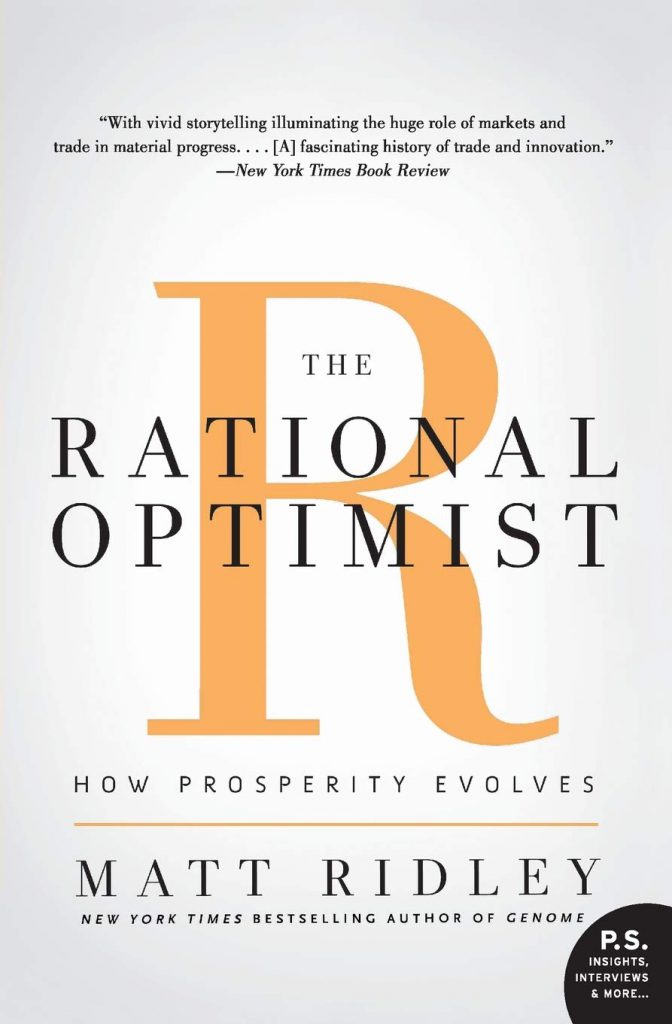
This review is a two for one special: The Rational Optimist: How Prosperity Evolves and How Innovation Works, both by Matt Ridley. One book leads into the other, so it’s a good pairing. Both books make the case that the world doesn’t suck quite as bad as we all thought, and discusses how life can get better through innovation. It’s a nice concept, so let’s start with some rational optimism.
I first encountered The Rational Optimist ten years ago in my college library. I didn’t read it then. The description on the back of the book claimed that “life is getting better at an accelerated rate”. I had to wipe off the back of the book after snorting in disbelief. This was before Covid, otherwise I would have used my ever-present disinfectant wipe. All of my college classes to date would blatantly disagree with the “life is getting better” statement.
It took me ten years and a lot of living before I finally read this book. The book stretches back in time to illustrate what life used to be for people all around the world. If you have ever watched historical movies, taken a history class, read books, or gone to a museum, you probably have an inkling of the comparatively primitive ways people onced lived. Ridley picks out excellent examples across history to demonstrate that quality of life is indeed improving.
At some point I set the book down and considered college. Many of the class discussions centered on why organizations, processes, government, and the interwoven systems of a nation were not working effectively right now. Depending upon the course, there was little discussion about how poorly those same systems worked in the past, if they even existed at all. Over time, there is definitely an improvement. If nothing else, The Rational Optimist made me look at the evolution of prosperity in a different way. Humans can now do more with less using different technology and processes. Consider the way we get around in trains, planes and automobiles. A series of systems were developed to leverage these technologies and diversify access. The system isn’t perfect, but in the grand scheme of things, transportation has come a long way.
Read the book for the deep dive, it’s interesting. But for the sake of time in this review, let’s fast forward to 2020 where Ridley digs into How Innovation Works. This book digs into the process of innovation. Innovation is “the turning of inventions into things of practical and affordable use to people”. Read the Goodreads description for the definition of innovation that got me to read the book. Innovation is necessary for change. It seems obvious, but it’s true.
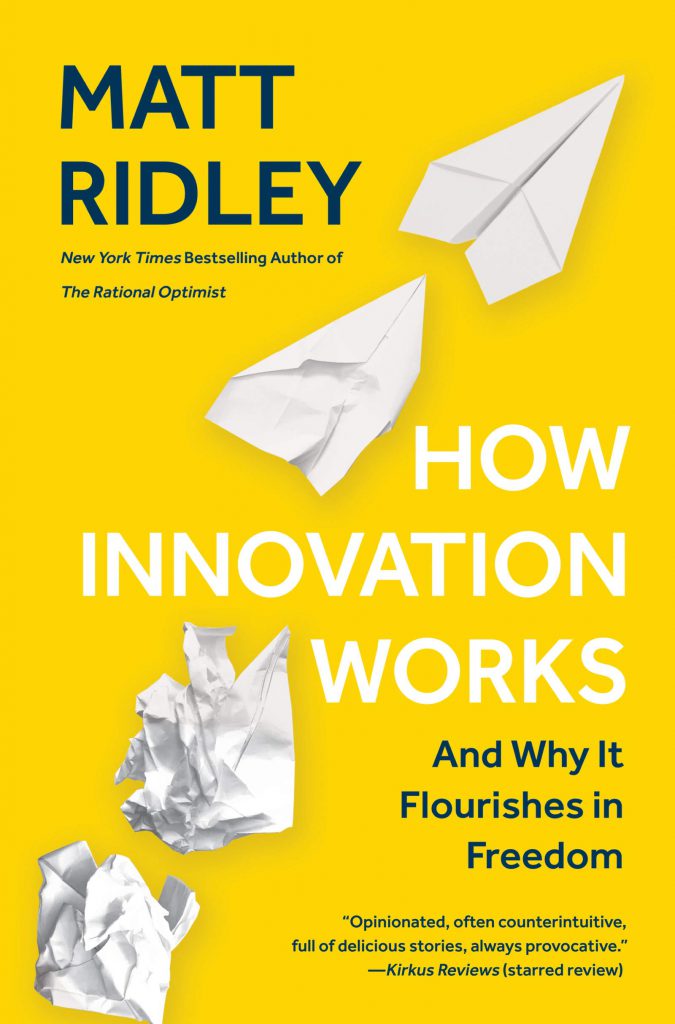
How Innovation Works tells the individual stories of innovations that have changed the world. Yes, the innovation of coffee did change the world. I heat water for coffee in my microwave. When I’m lazy, microwavable dinners save the day. Robots are making microwaves. I bought my microwave online. I find recipes for microwave meals on my smartphone. I find tutorials for robot STEM activities while my meal is cooking. I run on coffee. The world runs on innovation.
That is why schools and libraries everywhere are concentrating deeply on innovation. Think about the maker movement, STEM and STEAM activities. I started looking at the wider world and exploring problems that really need solving. Innovation happens when inventions solve a practical problem people face everyday. This book and others changed the way I look at innovation in the library. Look to the world for opportunities of innovation, then funnel innovation towards what matters most to people. It’s a work in progress.
Long story short: read the books. Good things will happen.
Ridley, Matt. How Innovation Works: And Why It Flourishes in Freedom, 2020. Print.
Ridley, Matt. “Rational Optimist.” New Scientist. 206.2766 (2010): 30-30. Print.
Friday Reads: The Finishing School Series by Gail Carriger
Imagine yourself in lovely Victorian-era England with grand homes, elegant balls, and a large steam powered dirigible school floating by.
Wait…what?
The Finishing School Series by Gail Carriger is an absolutely lovely young adult series that follows one Miss Sophronia Temminnick through her time at Mademoiselle Geraldine’s Finishing Academy for Young Ladies of Quality. Classes include “Fainting in a crowd to attract attention” and “Buying poison and planning dinner on a limited budget”.
Hold on! What?
As the books progress we’re taken out of Mademoiselle Geraldine’s Finishing Academy into the greater world. In Scotland we’re introduced to Sophronias friend Sidhegs pack, her grandfather and uncles, all of whom are werewolves. And to London where the vampires are trying to undermine a plot they just know the Picklemen are trying to run against them.
STOP!!!! WHAT IS GOING ON HERE?!?
I absolutely love this series! The fantasy elements are done in such a way as to seem completely plausible and familiar. This is neither a dystopian set of novels, which seem to be so popular these days, or a “princess in need of rescuing” story. These girls can take care of themselves thank you very much! Not a fan of YA? Most of Gail Carrigers other books all take place in this same lovely world but are decidedly not YA.
Oh! I almost forgot my favorite part – the mechanicals! Simple household type tasks are carried out by these steam and gear-powered robots. Sophronia happens upon one, which happens to look like a dachshund, early on in the series whom she eventually carries around like a purse. Isn’t that just the cutest thing?
Posted in Books & Reading
Tagged #FridayReads, books, Fantasy, Friday Reads, Reading, series
Leave a comment
Friday Reads: Eat the Buddha: Life and Death in a Tibetan Town, by Barbara Demick

Barbara Demick’s 2009 book, Nothing to Envy: Ordinary Lives in North Korea, blew me away with the eye-opening window it provided into everyday life in North Korea. In Eat the Buddha: Life and Death in a Tibetan Town, published this past July, Demick offers similar insight into Tibet by profiling a handful of individuals whose lived experiences paint a representative picture of life in a little-known land.
I’m guessing I’m not alone in my limited knowledge of Tibet. I associate it with the Dalai Lama, living in exile in India; Mount Everest, located on the border between Nepal and Tibet; and conflicts with the Chinese government, which claims sovereignty over it. After reading Demick’s book, I’ve definitely expanded my knowledge of the issues Tibetans have faced, particularly since 1950 when the Chinese army “liberated” them on behalf of Mao Zedong’s Communist Party.
Demick’s subjects tell tales of property seizure and struggle sessions. They also suffered from famine–a result of collectivization coordinated by cadres who ignored the delicate balance Tibetans had previously maintained between herding and high-altitude farming. Perhaps the biggest affront, however, was the Chinese government’s effort to suppress Tibetan’s religion, culture, and language through attacks on monks, monasteries, and the Dalai Lama:
Seeing the monks humiliated, statues smashed, and paintings burned shook Tibetans to the core. Buddhism provided the rituals through which the seasons were measured, births celebrated, and deaths grieved. . . . The attacks on religion alienated Tibetans who might otherwise have supported the Communist Party’s efforts to stamp out feudalism and create social equality. (48)
Not surprisingly, monasteries have become primary sites of contemporary Tibetan resistance. Initially demolished or repurposed in the late 1950s, monasteries started reopening in 1980. By 1994, however, the Communist Party had started cracking down on them again to “rein in Tibetan religious life” (144). Since then conflicts have escalated until, in 2009, a young monk set himself on fire, triggering a wave of self-immolations over subsequent years. (The 156th occurred on November 26, 2019.)
Due to the shocking nature of this means of political protest, self-immolations have received international media coverage. If you are like me, this may be the primary reason you have even the slightest inkling of what’s been happening in Tibet. If you’d like to learn more, however, you now have a book recommendation: Barbara Demick’s Eat the Buddha!
Demick, Barbara. Eat the Buddha: Life and Death in a Tibetan Town. New York: Random House, 2020.
Friday Reads: The Bookseller, by Cynthia Swanson
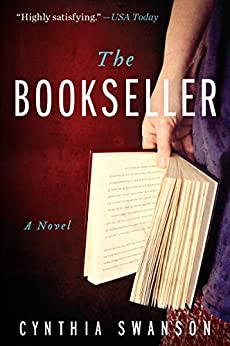
I am almost always drawn to books with the words book, bookshop, library or librarian in the title. The Bookseller, by Cynthia Swanson, caught my attention first with the title, then the unusual plot, then the location. Having lived in the Denver area for 22 years, this book was like walking down familiar streets again. I was hooked from the very first page, and I was 7/8’s of the way through before I figured out the awesome plot twist. I hope you enjoy it as much as I did!
Denver, 1962: Kitty Miller has come to terms with her unconventional single life. She loves the bookshop she runs with her best friend, Frieda, and enjoys complete control over her day-to-day existence. She can come and go as she pleases, answering to no one. There was a man once, a doctor named Kevin, but it didn’t quite work out the way Kitty had hoped.
Then the dreams begin.
Denver, 1963: Katharyn Andersson is married to Lars, the love of her life. They have beautiful children, an elegant home, and good friends. It’s everything Kitty Miller once believed she wanted—but it only exists when she sleeps.
Convinced that these dreams are simply due to her overactive imagination, Kitty enjoys her nighttime forays into this alternate world. But with each visit, the more irresistibly real Katharyn’s life becomes. Can she choose which life she wants? If so, what is the cost of staying Kitty, or becoming Katharyn?
As the lines between her worlds begin to blur, Kitty must figure out what is real and what is imagined, and learn to live with the result. (Amazon)
Friday Reads: Half Baked Harvest by Tieghan Gerard
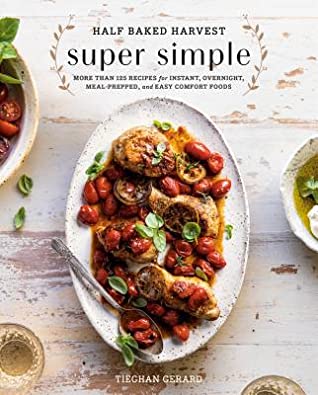
As we seem to be jumping right into winter weather this week, it’s the best time for soups, comfort foods in general, and so much baking.
Tieghan Gerard’s Half Baked Harvest Super Simple is my current favorite cookbook with “more than 125 recipes for instant, overnight, meal-prepped, and easy comfort foods.” Recipes like browned sage-butter chicken pot pie” (p. 172) or broccoli cheddar soup (p. 94) are perfect for cold, rainy/snowy weeknights.
The recipes are divided into: basics, breakfast and brunch, appetizers and sides, salad and soup, pizza and pasta, vegetarian, poultry and pork, beef and lamb, seafood and fish, and dessert. Each recipe fits on a single page with a short personal note from Tieghan (such as growing up in the Ohio and her love of Top ramen which has now become a more “grown-up” version with garlic-butter noodles). She includes different instructions for cooking on a stovetop, pressure cooker, or slow cooker, as well as ingredient alternatives. The recipes are intended to be fairly easy to make without a long list of ingredients. Some recipes include premade or store-bought items, like her Blondie Brownie Bars (p. 274) which includes a boxed brownie mix or the Creamy Chicken Gnocchi Soup (p. 91) which includes a box of mini potato gnocchi. But some days, there’s just not time to make everything from scratch and the recipes make them super delicious. (She also has a five ingredient hazelnut brownie recipe or cinnamon rolls with chai frosting which are both incredibly easy and wonderful.)
Along with the recipes, the photography in this book is gorgeous. The book is well worth checking out just to look at the pretty pictures of delicious food.
Gerard, T. Half baked harvest super simple. Clarkson Potter. 2019.
Friday Reads: How To Know The Birds by Ted Floyd

Birding, or bird-watching, has grown in popularity as an enjoyable activity that allows for social distancing. Birding also lets us re-center ourselves while connecting with the natural world. Of course, birding was a popular pastime even before 2020, and there are lots of books on the topic. Ted Floyd’s book, How to Know the Birds, takes a refreshing and elegant approach that will intrigue new and seasoned birders alike.
Floyd structures the book in a new way. He takes the stages of interest in birding, and lays them over the natural seasons and how those affect birds and birding, and then explores those themes by discussing one bird at a time, in a personal way. It reads much more easily than that description might lead you to believe! Each section is a bite-sized chunk that can be devoured quickly. A reader could jump around in the book, as one might with a traditional bird field guide, or read it beginning to end. This book is a good resource for the new or the experienced birder, and it would also be a great gift for the seasoned birder that thinks they’ve read all the bird books.
Floyd, Ted, and N J. Schmitt. How to Know the Birds: The Art & Adventure of Birding. , 2019. Print.
Friday Reads: Break Shot: My First 21 Years by James Taylor
More accurately described – Friday listens, this title is available exclusively from Audible.com. Break Shot was recorded by James in his home studio, TheBarn in western Massachusetts and released in conjunction with his 19th studio album, American Standard. At only an hour and a half, I listened twice, enjoying it even more the second time. It begins with the following: “I’m James Taylor and I’m a professional autobiographer. I usually talk about myself with a guitar in my hand and I have one now.” James explains that the title is an analogy for his tight knit family that eventually split apart “like a break shot in the game of pool … when you slam the cue ball into the fifteen other balls and they all go flying off.” James and his four siblings were raised with great privilege in North Carolina in the ‘60’s but the family fell apart. Three of the kids ended up in psychiatric hospitals. Drug and alcohol addiction took their toll.

Despite coming from a family of doctors and lawyers, James wasn’t interested in college. His parents supported his decision to spend tuition money on a flight to London. This trip provided the pivotal moment of his life. Through life-long friend Danny Kortchmar, James met with Peter Asher, the head of A&R (Artist & Repertoire) at Apple Records and played his demo tape. Peter liked what he heard and recalls calling out, “is there a Beatle in the house?” James auditioned for Paul McCartney and George Harrison with the song Something in the Way She Moves. James’ first album James Taylor, was the first recording by a non-British artist released by Apple Records in 1968.
Break Shot didn’t provide a great deal of revelatory information, so much of James’ life is in his lyrics, but the storytelling intertwined with the recorded songs provided an experience you can’t have with a printed book. This audio memoir was for me, a private concert. This recording is part of a new series, Words+Music, Audible’s musical storytelling initiative. With other exclusive music biographies by Tom Morello, Common, St. Vincent, Sheryl Crow, and T Bone Burnett, I hope other audio publishers will begin providing similar recordings.
Friday Reads: Nobody Will Tell You This But Me: A true (as told to me) story by Bess Kalb
I listened to this audiobook from Lincoln City Libraries through my Libby App. Narrated by the author, it’s a short 4 hours, the perfect listen for a road trip. I looked up Bess Kalb’s book after reading the following statement “Last year at a party a writer I respect called my pregnant stomach a ‘career-ender’ and now I’m the head writer of a show I sold to a major network and yesterday I signed the deal paying me to write a movie based on the book I finished 5 weeks postpartum, so do you like apples?” and I thought… yes, this is a woman whose book I’d like to read.
Some relationships are meant to be memorialized, the voices of our loved ones with us even after they’re gone. Such is the memoir of Bess Kalb and her maternal grandmother “Grandma Bobby.” Kalb recounts three generations of family history, mostly focused on the women, in a succinct and heartwarming account. The author doesn’t gloss over the true-to-life relationships of her family but displays them in all their messy glory. The result is a series of recounted conversations, family tales, and verbatim voicemail messages left by her grandmother. Kalb saved every one her Grandma Bobby ever left her. I admit, I laughed and cried as these people, flaws and all, came to life. Relationships and family especially can be messy, filled with misunderstanding, pride, and rough edges that rub, but through all of this, the spunky voice of Grandma Bobby is clear, that and her love for her granddaughter.
Kalb, Bess. Nobody Will Tell You This But Me: A true (as told to me) story. Penguin Random House Audio. 2020.
Posted in Books & Reading
Tagged Audiobook, Bess Kalb, Book Review, Friday Reads, Memoir, Nobody Will Tell You This But Me
Leave a comment
Friday Reads: The Dutch House by Ann Patchett
Ann Patchett’s Bel Canto was the first book that I read of this author’s many books. At the time, it was Lincoln City Libraries’ selection for its One Book – One Lincoln community reading project. That book led to reading several other of Patchett’s novels and memoirs. The Dutch House is Patchett’s eighth novel and shares characteristics of her previous books. Common are interesting settings, shifting timelines, well-drawn characters, blended families, and complicated relationships. Notable are Patchett’s skilled writing, wit, and imaginative stories. Dutch House (a mansion near Philadelphia) is both background and central to the story.
Somewhat akin to a fairy tale, Danny and Maeve Conroy, brother and sister, are the central characters (Hansel and Gretel?). There are the experiences of abandonment, banishment, the evil stepmother, and not-at-all evil stepsisters. Danny is the book’s first-person narrator. Danny’s and Maeve’s closeness over five decades evolves from their early childhood loss of mother and father. Interesting to me was the dialogue. Though, dialogue was especially notable because I listened to the audiobook narrated by Tom Hanks, perhaps more accurately described as performed by Hanks.
Patchett, Ann. The Dutch House. HarperCollins. 2019.
Friday Reads: B is for Beer

This book is described, appropriately, as a children’s book for grown-ups or a grown-up book for children. In addition to reading it myself, my 9 year old and my 13 year old also enjoyed it. The book, obviously, is about beer. It details the history and finer facts about beer, weaved into the story of young Gracie Perkel, a 6 year old living in the Pacific Northwest, namely, Seattle. Gracie becomes interested in the stuff her daddy and uncle Moe (who steals the show) drink, that looks like “pee-pee”. Robbins has a way of describing the mundane in a way that brings hilarity into the room. In this story, that is Gracie’s interactions with Moe (full time beer drinker, part-time philosopher), a visit from the Beer Fairy, and the condescending teetoaler Sunday school teacher (who’s breath transcends bad, having the potency to “paralyze a rattlesnake”). At any rate, the novel is a good mix of the plot story of Gracie’s life, the life of Moe, Gracie’s parents (mostly her mom), and the beer stuff.
Robbins suggests this is a good book for a grandpa to read to his grandkids, whilst cracking a “cold one”. It very well may be. At least it is an entertaining and quick read.
Robbins, T. B is for Beer Ecco, 2009.
Friday Reads: Pumpkinheads by Rainbow Rowell
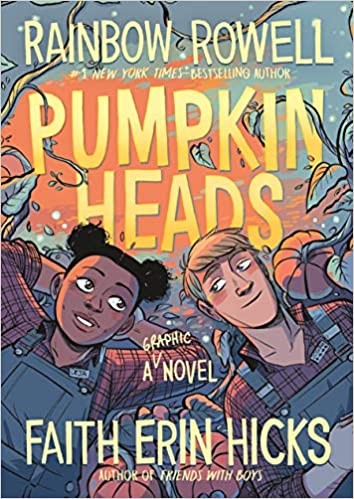
Is there anything better than a crisp cool night at the pumpkin patch in the fall? The smell of campfire smoke, kettle corn, and apple cider in the air?
Deja and Josiah have been partners in the Succotash Hut for 4 seasons at the world’s greatest pumpkin patch. It’s their last night, and Deja is on a mission to get Josie to finally talk to his long-time crush at The Fudge Hut…and score some snacks along the way.
This YA graphic novel by Nebraska author Rainbow Rowell and Canadian artist Faith Erin Hicks was the perfect quick read to kick off my autumn. While I may not visit the local pumpkin patch this year (darn you coronavirus!), I am definitely ready for s’mores, fire pits, and pumpkin pie.
Rowell, Rainbow. Pumpkinheads. First Second Books, 2019.
Posted in Books & Reading, General
Tagged #FridayReads, Book Review, Friday Reads, graphic novel, Rainbow Rowell, YA
Leave a comment
Friday Reads: Tempest Tossed
September is Library Card Sign-up Month! And ALA has named Wonder Woman as this year’s Library Card Sign-up Month Honorary Chair.
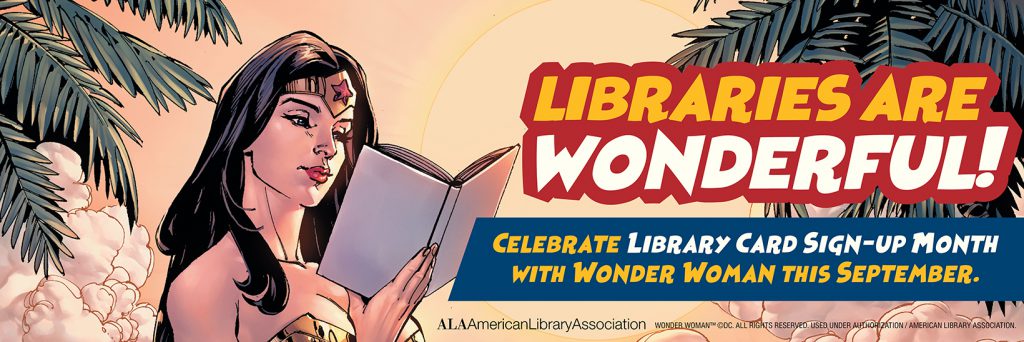
To celebrate, I read the new graphic novel, Wonder Woman: Tempest Tossed, written by Laurie Halse Anderson and illustrated by Leila Del Duca.

Tempest Tossed is a re-imagining of Wonder Woman’s origin story. While it is part of DC’s Graphic Novels for Young Adults imprint, it is definitely a book for all ages.
Some of the story is familiar. Unlike the other Amazons who were created on Themyscira as adults, Princess Diana was molded out of clay as a baby by her mother, Queen of the Amazons. So, she is the only person on the island who actually grew up, through the terrible toddler years and into teenage puberty. Since none of the other Amazons have gone through this, the changes that Diana experiences are very confusing to them. Mood swings, her body developing, acne, growth spurts making her awkward and clumsy. This causes some of the other Amazons to call her the Changeling. Definitely something that anyone reading this book will identify with.
As she reaches her 16th Born Day, rafts full of refugees fleeing their war-torn country break through holes in the barrier protecting Themyscira, and Diana goes against Amazon rules to help save a group from drowning. But, she ends up trapped outside the barrier on the refugee’s raft and cannot return to her home. She becomes a refugee herself.
The raft eventually finds land, and Diana is thrown into a new and foreign world. We follow her personal experience navigating the refugee process, as she learns about the struggles and failures of the immigration system. She also makes new friends and works with them to fight new injustices – homelessness, poverty, food insecurity, child trafficking. Through Diana’s eyes readers are exposed to the harsh realities of being poor in our world.
On a lighter note, I also really enjoyed the version of Steve Trevor in the story. No spoilers! I won’t give anything away, but it’s one of the most unique portrayals I’ve read and perfect for our times.
Posted in Books & Reading, Youth Services
Tagged #FridayReads, Friday Reads, FridayReads
Leave a comment
